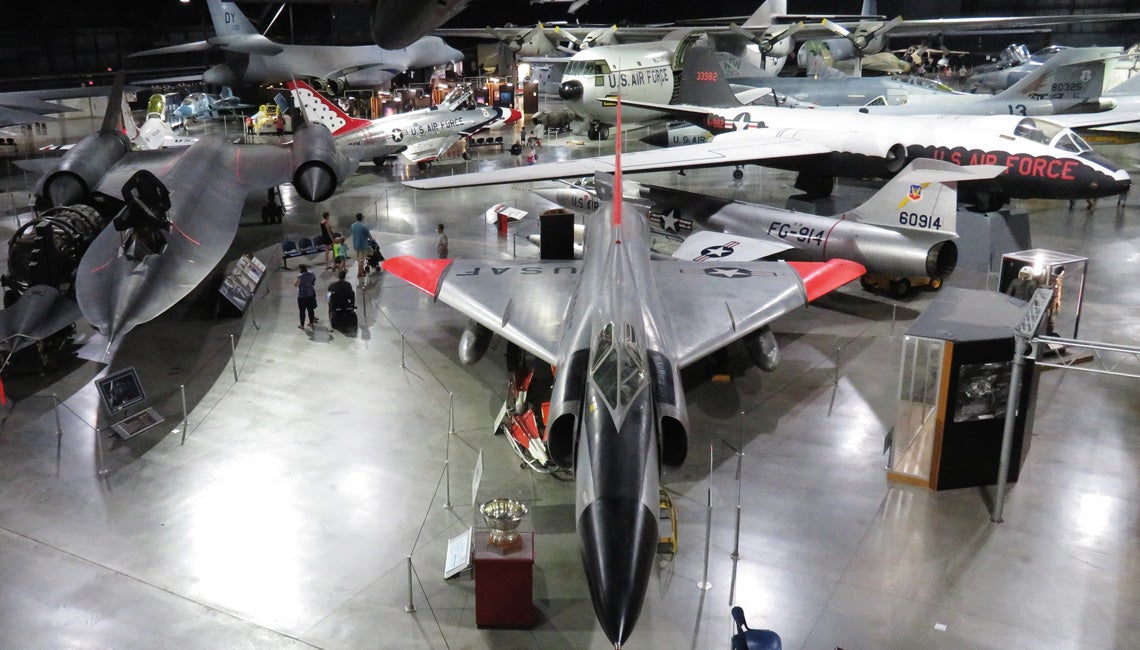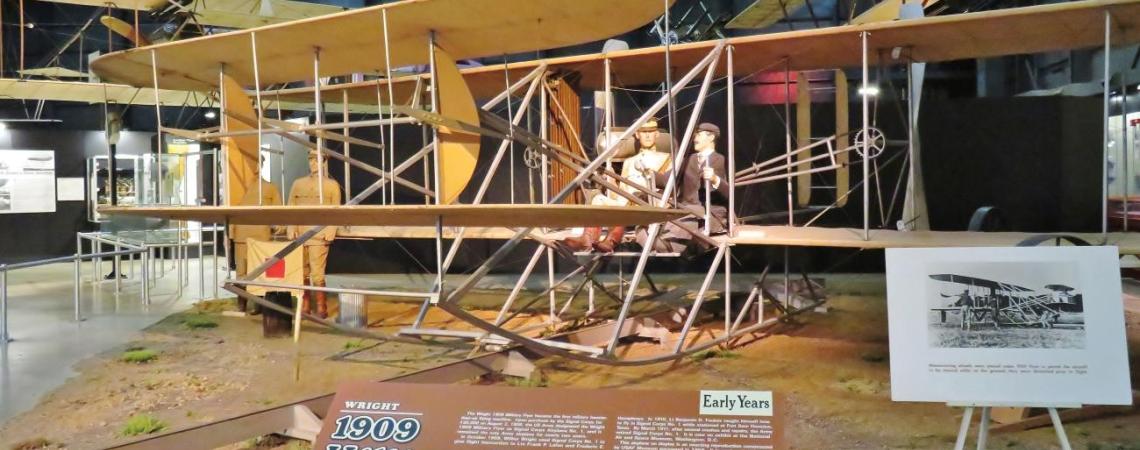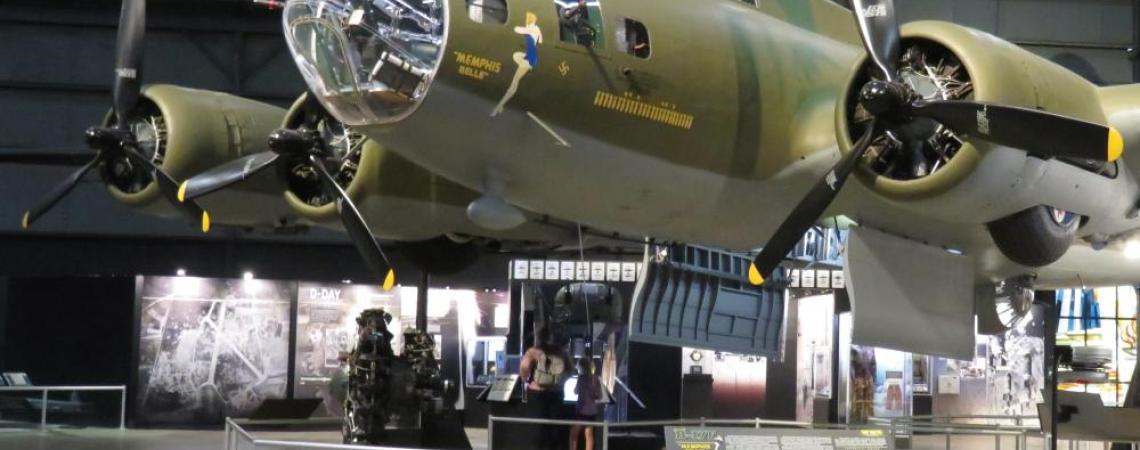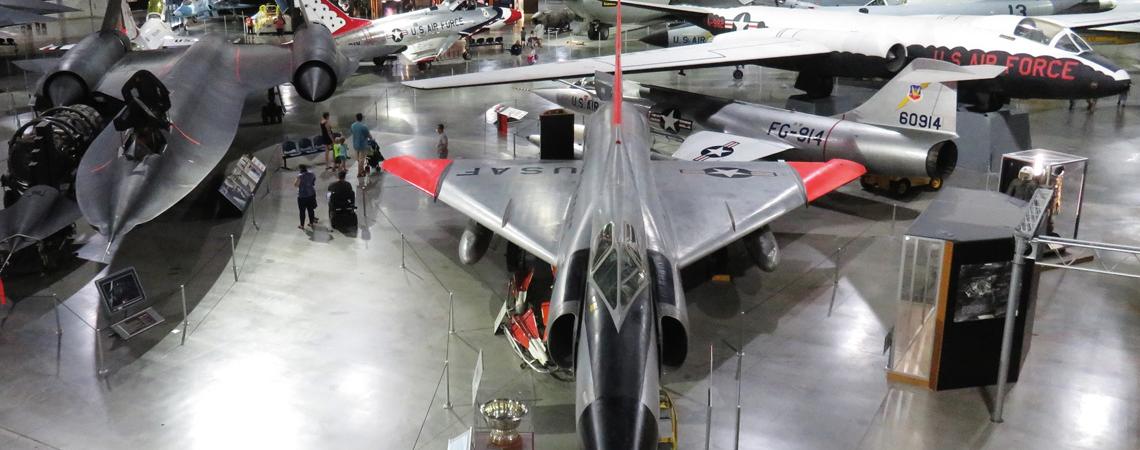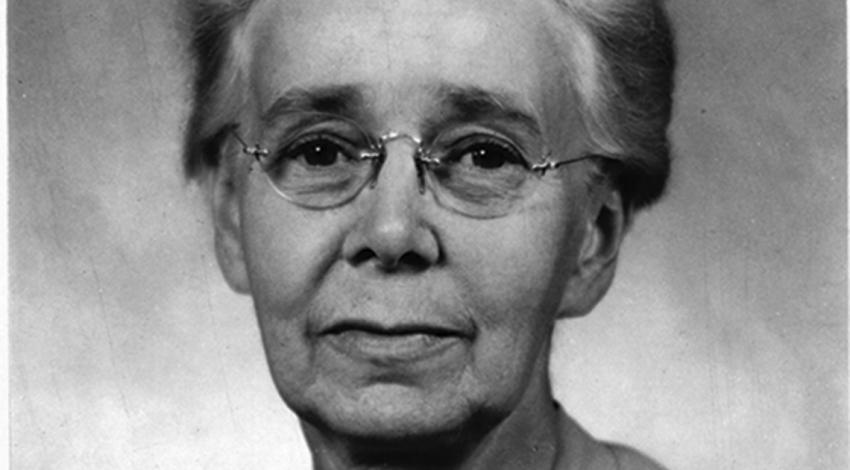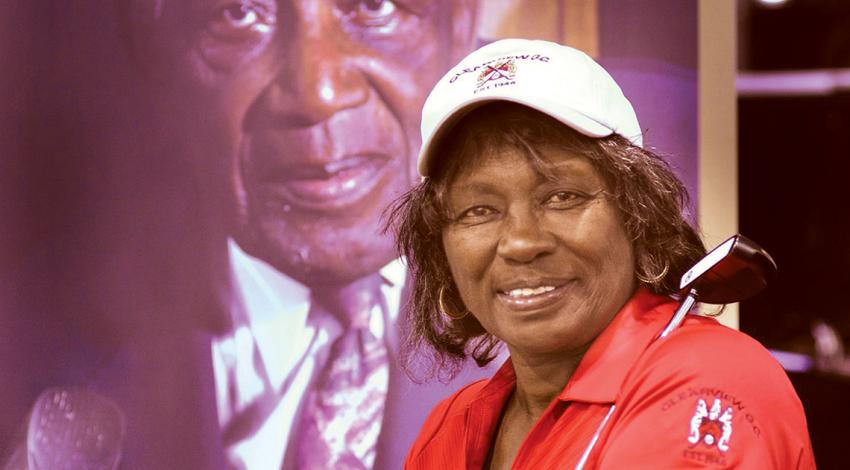Born and raised in Columbus, Air Force General Curtis LeMay studied engineering at Ohio State University and launched his military career in his hometown by learning to fly at old Norton Field. The bombing raids he directed during World War II clinched Lemay’s reputation as a disciplinarian, and in 1948, the cigar-chomping general known as “Old Iron Pants” was tapped to oversee operations for the Berlin Airlift.
Code-named Operation Vittles, the airlift famously foiled a Soviet Union blockade with nonstop cargo flights that delivered life-saving food and fuel to beleaguered West Berliners.
Wright Brothers 1909 military flyer
One airlift pilot, Lt. Russ Steber, took along his newly adopted boxer rather than leave the pup alone during the lengthy missions. The dog became such a familiar part of the airlift, Steber even had a parachute made for him. Eventually, LeMay learned of the stowaway, and Steber expected to be in big trouble. Instead, the general told Steber his dog was a great morale booster and promptly named him “Vittles.”
Fortunately, Vittles never needed the parachute, and the National Museum of the United States Air Force now showcases Vittles’ full flight gear in its Berlin Airlift exhibit. “LeMay was a gruff commander,” says museum historian Douglas Lantry, “but our Vittles display gives people insight into his humanitarian impulses in the midst of a difficult and dangerous job.”
The Air Force Museum is located on Wright-Patterson Air Force Base outside of Dayton, where Orville and Wilbur Wright invented the airplane. It’s the world’s largest military aviation museum, boasting more than 350 aerospace vehicles and missiles plus countless artifacts that range from a 1918 wind tunnel to videos of Bob Hope entertaining airmen in Vietnam to the Distinguished Service Cross that General Dwight Eisenhower personally presented to World War II’s “Ace of Aces” — and Piqua native — Capt. Don Gentile.
The Air Force Museum, which turns 100 this year, is also the world’s oldest military aviation museum, and although it currently consists of four hangar-style buildings containing over 19 acres of exhibit space, the museum’s origin was considerably more modest. It began in May 1923, when personnel at Dayton’s McCook Field amassed numerous aircraft engines and other equipment in the corner of a hangar and invited the public to have a look. Because of Dayton’s rich tradition of innovation, the Army Air Service (the Air Force’s precursor) had established McCook Field as its aviation research and development center in 1917. A decade later, the burgeoning research facilities and budding museum permanently moved to Wright Field at present-day Wright-Patterson AFB.
Today, the Air Force Museum ranks among Ohio’s most popular attractions, annually drawing about a million visitors from around the globe. While people certainly come for its unrivaled array of aircraft, they also discover that the museum preserves remarkable stories about individuals, technological milestones, and American culture. “The museum’s starting point coincides with the United States emerging as a world power,” notes Lantry, “and its collections illustrate the tremendous changes occurring during the last 100 years.”
For the museum’s centennial, Lantry is helping to curate a special heritage exhibit. “We’ll be displaying many archival materials that people practically never get to see.” Those rare items include the handwritten diary kept by World War I ace and Medal of Honor recipient Eddie Rickenbacker as well as historic B-17 technical manuals that the museum’s restoration staff used to piece together the iconic World War II bomber, Memphis Belle.
“Every visitor should see the Memphis Belle exhibit, because it represents the lives of 30,000 airmen lost in the air battles over Europe,” says Lantry. “The plane is the equivalent of the Iwo Jima Memorial as an emotional touchstone for service and sacrifice.”
Of course, Memphis Belle is hardly the only storied item in the museum, and in a nod to the museum’s centennial, Lantry has selected 10 other must-see exhibits that embody the history of military aviation and the nation.
Wright 1909 Military Flyer
The Wright brothers built the world’s first military airplane — Signal Corps Airplane No. 1 — for the U.S. Army. Though it’s a reproduction, the exhibit features an engine donated by Orville Wright. “It’s worth seeing,” says Lantry. “Compared to today’s technology, the Military Flyer was on a completely different planet.”
De Haviland DH-4 (aka the “Liberty Plane”)
A wood and fabric biplane, the DH-4 was World War I’s only American-made combat aircraft, and its Liberty 12 engine was developed at McCook Field. Says Lantry, “Liberty Planes taught lots of Americans how to fly and lots of Americans how to make airplanes.”
B-29 “Bockscar”
The airplane that ended World War II: “After it dropped the second atomic bomb on Nagasaki,” Lantry says, “Japan surrendered.”
Cold War Gallery’s B-36J Peacemaker
A strategic bomber that embodies America’s commitment to air power in the 1950s. “It was called the Peacemaker,” Lantry says, “because of its ability to deliver nuclear weapons anywhere in the world.”
SR-71A “Blackbird”
The futuristic-looking spy plane flew from 1966 to 1990. “It’s world-renowned for being the fastest aircraft ever built,” Lantry says, “an outstanding example of American aircraft design and engineering.”
The F-86A Sabre and MiG-15
The American F-86 and Soviet MiG are displayed side by side because their Korean War dogfights represent the birth of modern air combat. “These jets changed the whole calculus of what airplanes could do and how they should be used in combat.”
The Presidential Gallery’s SAM 26000
Delivered to the Air Force in 1962, it was the first jet aircraft specifically built for U.S. presidents. On November 22, 1963, this Air Force One took John Kennedy to Dallas and later returned the assassinated president’s body to Washington, D.C. “The SAM 26000 transported eight presidents,” notes Lantry, “and was the vehicle for many historical moments like Johnson’s swearing-in and Nixon’s trip to China.”
B-52D Stratofortress
B-52 heavy bombers have been the Air Force’s global workhorse since 1955. “B-52s symbolize American air power, and their shape is unmistakable.”
Apollo 15 Command Module Endeavour
Launched in 1971, Apollo 15 was the first moon landing mission to both emphasize science and use a lunar rover vehicle. Says Lantry, “It was the only Apollo mission with an all-Air Force crew and demonstrates the service’s commitment to human space flight.”
Titan IVB Rocket
Used from 1996 to 2005, Titan IVBs were powerful, single-use rockets that launched everything from meteorological satellites to the Cassini-Huygens space probe that revealed the wonders of Saturn. “It’s 204 feet long and super-impressive to see or stand under,” says Lantry.
Admission and parking are free at the National Museum of the United States Air Force, and its family-friendly 100th anniversary celebrations will include a centennial exhibit scheduled to open May 20; an ongoing Enlisted Forces exhibit; and a Planes, Trains, and Automobiles model event. Other activities and events will be added throughout 2023. For details and dates, telephone 937-255-3286 or visit www.nationalmuseum.af.mil.
